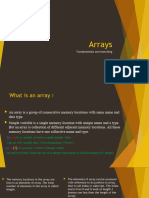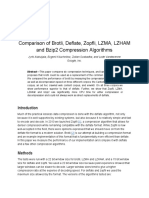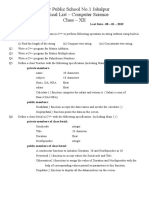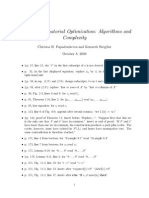Module 4: Arrays and Indexing Types (Week 2)
4.1 Introduction
An Array is a linear data structure that collects elements of the same data
type and stores them in contiguous and adjacent memory locations. A Linear
array is a list of a finite number n of homogeneous data elements (i.e., data
elements of the same data type) such that
(a) The elements of the array are referenced respectively by an index set
consisting of n consecutive numbers.
(b) The elements of the array are stored respectively in successive
memory locations.
Thus, an Array is a collection of variables of the same data types that are
referred to using a common name. An array has a name, size, index and
elements.
4.2.1 Properties of an Array
Some of the properties of an array that are:
(i) Each element in an array is of the same data type and carries the same
size.
(ii) Elements in the array are stored at contiguous memory locations from
which the first element is stored at the smallest memory location.
(iii) Elements of the array can be randomly accessed since we can calculate
the address of each element of the array with the given base address
and the size of the data element.
4.2.2 The Need for Arrays
Arrays are useful because:
(a) Sorting and searching a value in an array is easier.
(b) Arrays are best to process multiple values quickly and easily.
Page 1 of 19
� (c) Arrays are good for storing multiple values in a single variable. In
computer programming, most cases require storing a large amount of
data of a similar type. To store such an amount of data, we need to
define a large number of variables. It would be very difficult to
remember the names of all the variables while writing the programs.
Instead of naming all the variables with a different name, it is better to
define an array and store all the elements into it.
(d) Arrays provide O(1) random access lookup time. That means, accessing
the 1st index of the array and the 1000th index of the array will both
take the same time. This is due to the fact that array comes with a
pointer and an offset value. The pointer points to the right location of
the memory and the offset value shows how far to look in the said
memory.
4.3 Indexing Types and Memory Representation
Two important terms needed to understand the concept of an Array are the
array element and array index.
(a) Element: Each item stored in an array is called an element. Elements
of an array may be denoted denoted by subscript notation a1, a2, a3 . .
. an by via:
▪ Subscription A1…An
▪ Parenthesis A(1)…A(n)
▪ Bracket Notation A [1]…A[n]
(b) Index: Each location of an element in an array has a numerical index,
which is used to identify the element.
Figure 4.1: Array Elements Array Values) and Array Index
Page 2 of 19
�The difference between an array index and a memory address is that the array
index acts like a key value to label the elements in the array. However, a
memory address is the starting address of free memory available.
When representing an Array in memory, all the data elements of an array are
stored at contiguous locations in the main memory. The name of the array
represents the base address or the address of the first element in the main
memory. Each element of the array is represented by proper indexing.
We can define the indexing of an array in the below ways:
▪ 0 (zero-based indexing): The first element of the array will be arr[0].
▪ 1 (one-based indexing): The first element of the array will be arr[1].
▪ n (n - based indexing): The first element of the array can reside at any
random index number. Usually programming languages allowing n-
based indexing also allow negative index values and other scalar data
types like enumerations, or characters may be used as an array index.
Figure 4.2: Memory Representation of an Array
The Figure 4.2 above shown the memory allocation of an array “arr” of size
5. The array follows a 0-based indexing approach. The base address of the
array is 100 bytes. It is the address of arr[0]. Here, the size of the data type
used is 4 bytes; therefore, each element will take 4 bytes in the memory.
Let Arr be a linear array in the memory of the computer. The following
information given below to access any random element from the array:
▪ Base Address of the array.
▪ Size of an element in bytes.
▪ Type of indexing,
Recall that the memory of computer is simply a sequence of addressed
locations.
Page 3 of 19
� LOC (Arr[k]) = address of element Arr[k] of the array Arr.
Since the elements of Arr are stored in the successive memory cells.
Accordingly, the computer does not need to keep track of the address of every
element of Arr array but needs to keep track only of the address of the first
element of Arr array denoted by Base (Arr) of array, the base address of Arr
array. Using base address, the computer calculates the address of any
element of Arr array by the following formula:
Byte address of element Arr[i] = base address(Arr) + storage size * ( i - first index)
Here, size represents the memory taken by the primitive data types. As an
instance, int takes 2 bytes, float takes 4 bytes of memory space in C++.
For example, Suppose an array, Arr[-10 . . .+2 ] having Base address (BA) =
999 and size of an element = 2 bytes, find the location of A[-1].
Loc(Arr[-1]) = 999 + 2 x [(-1) - (-10)]
= 999 + 18
= 1017
4.4 Length vs Size of an Array
The number n of elements is called length or size of array. If not explicitly
stated, we will assume the index set consists of integers 1, 2, 3 …n. In general,
the length or the number of data elements of the array can be obtained from
the index set by the formula:
Length= UB – LB + 1
Where UB is the largest index, called the upper bound, and LB is the smallest
index, called the lower bound. Note that length = UB when LB = 1.
Figure 4.3: Upper and Lower Bound of an Array
Page 4 of 19
�4.5 Type of Arrays
An array can be classified based on its dimensions and as static or dynamic
array.
Static Arrays are arrays for which the size or length is determined when the
array is created and/or allocated. For this reason, they may also be referred
to as fixed-length arrays or fixed arrays. The size of static arrays is determined
at compile-time (before run-time), and no need to delete static arrays because
they are deleted automatically after going out of scope. Array values may be
specified when the array is defined, or the array size may be defined without
specifying array contents. Depending on the programming language, an
uninitialized array may contain default values, or it may contain whatever
values were left in memory from previous allocation.
Dynamic array is a random access, variable-size list data structure that
allows elements to be added or removed. Dynamic Arrays are allocated
on heap. Dynamic arrays overcome the limit of static arrays, which have a
fixed capacity that needs to be specified at allocation. Dynamic arrays allow
elements to be added and removed at runtime. Most current programming
languages include built-in or standard library functions for creating and
managing dynamic arrays.
4.6 Rank/Dimension of an Array (One, Two and Multidimensional
Array)
There can be various types of arrays based on their dimensions such as One
dimensional, two dimensional and Multidimensional.
(a) One-dimensional Array
When elements of an array are arranged in a linear fashion, it is called a one-
dimensional array. It is the basic array we generally use in many problems.
The syntax of declaring one-dimensional array a one-dimensional array is
given as follows.
type arr[max_columns]
(b) Two-dimensional Array
2D array can be defined as an array of arrays. The 2D array is organized as
matrices which can be represented as the collection of rows and columns.
However, 2D arrays are created to implement a relational database look alike
data structure. It provides ease of holding bulk of data at once which can be
passed to any number of functions wherever required.
Page 5 of 19
�The syntax of declaring two-dimensional array is very much similar to that of
a one-dimensional array, given as follows.
type arr[max_rows][max_columns]
(c) Multidimensional dimensional Array
When there is more than two dimensions of the array, it is called a multi-
dimensional array. It can be 3D, or more dimensional. For example, the
diagram below illustrates a three-dimensional array.
int a[size1][size2][size3]
4.7 Arrays Declaration
Arrays are typically defined with square brackets with the size of the arrays
as its argument.
For One-dimensional array, the declaration is:
int arr[max_columns]
e.g.
Int a[10];
Page 6 of 19
�For Two-dimensional array, the declaration is:
int arr[max_rows][max_columns]
e.g.
int arr[5][5];
For Three-dimensional array, the declaration is:
int [size1][size2][size3];
e.g.
int a[5][5][5];
4.8 Manipulating the Content of Array (Arrays Operations)
The basic operations performed by an Arrays are:
(a) Traversal: print all the array elements one by one.
(b) Insertion: Adds an element at the given index.
(c) Deletion: Deletes an element at the given index.
(d) Search: Searches an element using the given index or by the value.
(e) Sorting: Arranging the elements of an Array in an order either in
ascending or descending order.
(f) Update: Updates an element at the given index.
(g) Merging: Combining the contents of two Arrays
4.8.1 Traversal
Traversal is a process of processing or visiting each element in the array
exactly once. Let A be an array stored in the computer’s memory. If we want
to display the contents of A, it has to be traversed i.e., by accessing and
processing each element of A exactly once. The algorithm for Traversal is
shown below:
Algorithm: (Traverse a Linear Array)
TRAVERSAL (LA, LB, UB, K)
[Here LA is a Linear array with lower boundary LB and upper boundary
UB. This algorithm traverses LA applying an operation Process to each
element of LA].
Step 1. [Initialize counter.] Set K ← LB.
Step 2. Repeat Steps 3 and 4 while K ≤ UB.
Step 3. [Visit element.] Apply PROCESS to LA[K].
Step 4. [Increase counter.] Set K ← K + 1.
[End of Step 2 loop.]
Step 5. Exit.
Page 7 of 19
�The alternate algorithm for traversing (using for loop) is:
Algorithm: (Traverse a Linear Array)
[This algorithm traverses a linear array LA with lower bound LB and
upper bound UB.]
TRAVERSAL (LA, LB, UB, K)
Step 1. Repeat for K= LB to UB
Apply PROCESS to LA[K].
[End of loop].
Step 2. Exit.
4.8.2 Insertion
Insert operation insert one or more data elements into an array. Based on the
requirement, a new element can be added at the beginning, end, or at any
given index of the array. Let A be a collection of data elements in the memory
of the computer. "Inserting" refers to the operation of adding another element
to the collection A. Inserting an element at the "end" of a linear array can be
easily done provided the memory space allocated for the array is large enough
to accommodate the additional element. On the other hand, suppose we need
to insert an element in the middle of the array. Then, on the average, half of
the elements must be moved downward to new locations to accommodate the
new location and keep the order of the other elements. The algorithm for
Inserting.
Algorithm: (Inserting into a Linear Array)
INSERT (LA, N, K. ITEM)
[Here LA is a linear array with N elements and K is a positive integer
such that K ≤ N. This algorithm inserts an element ITEM into the Kth
position in LA].
Step I. [Initialize counter.] Set J← N.
Step 2. Repeat Steps 3 and 4 while J ≥ K.
Step 3. [Move Jth element downward.] Set LA [J + 1]←LA[J].
Step 4. [Decrease counter] Set J← J— 1.
[End of Step 2 loop.]
Step 5. [Insert clement] Set LA[K] ← ITEM.
Step 6. [Reset N.] Set N ← N+1
Step 7. Exit
Page 8 of 19
�4.8.3 Deletion
Deletion refers to removing an existing element from the array and re-
organizing all elements of an array. Let A be a collection of data elements in
the memory of the computer. "Deleting" refers to, the operation of removing
one of the elements from A. Deleting an element at the "end" of an array
presents no difficulties, but deleting an element somewhere in the middle of
the array would require that each subsequent element be moved one location
upward in order to "fill up" the array.
Algorithm: Deleting from a Linear Array)
DELETE (LA, N, K, ITEM)
[Here LA is a linear array with N elements and K is a positive integer
such that K ≤ N. This algorithm deletes the Kth element from LA.]
Step 1: Set ITEM ←LA(K)
Step 2: Repeat for J = K to N - 1:
[Move J + 1st clement upward.] Set LA(J) ← LA [J + I).
[End of loop,]
Step 3: [Reset the number N of elements in LA.) Set N: ← N - I.
Step 4: Exit.
4.8.4 Search
The process of finding a particular element of an array is called Searching. If
the item is not present in the array, then the search is unsuccessful. A search
can be performed on an array element based on its value or its index.
Algorithm
Consider LA is a linear array with N elements and K is a positive integer such
that K<=N. the algorithm to find an element with a value of ITEM using
sequential search.
SEARCH [LA, N, K, ITEM]
Step 1. Start
Step 2. Set K=0
Step 3. Repeat steps 4 and 5 while K < N
Step 4. IF LA[K] is equal ITEM THEN GOTO STEP 6
Step 5. Set K = K +1
Step 6. PRINT K, ITEM
Step 7. Stop
Page 9 of 19
�4.8.5 Update
Update operation refers to updating an existing element from the array at a
given index.
Algorithm
Consider LA is a linear array with N elements and K is a positive integer such
that K<=N. The algorithm updates an element available at the Kth position of
LA.
UPDATE [LA, K, ITEN]
Step 1. Start
Step 2. Set LA[K] = ITEM
Step 3. Stop
4.8.6 Merging
Merging two arrays means combining two separate arrays into one single
array. For instance, if the first array consists of 3 elements and the second
array consists of 5 elements then the resulting array consists of 8 elements.
This resulting array is known as a merged array.
The steps to merge two arrays are:
Step 1: Start
Step2: Create an array of size m+n named nums3[].
Step 3: Copy all elements of nums1[] to nums3[].
Step 4: Now traverse the elements of nums2[] and insert elements one
by one to nums3[]
Step 5: Stop
The Merging Algorithm is given below:
Algorithm: MERGE (A, L, N1, R, N2)
1. Set i:=0, j:=0.
2. Repeat for k=0,1,2 . . . . . (N1+N2-1)
If i<N1, then:
If j=N2 or L [i] ≤ R [j], then:
Set A [k] =L [i].
Set i=i+1;
Else:
If j < N2, then:
Set A [k]=R [j].
Set j=j+1.
[Endif]
[Endif]
[End Repeat Loop]
3. Return
Page 10 of 19
�4.9 Complexity of Array Operations
The Time complexity of various array operations are described in the following
table.
Time Complexity Space
Operation Best Average Worst Complexity
Case Case Case
Access/Traversal O (1) O (1) O (1) O (1)
Search O (1) O(n) O(n) O (1)
Insertion O (1) O(n) O(n) O (1)
Deletion O (1) O(n) O(n) O (1)
In array, space complexity for worst case is O(n).
4.10 Advantages and Disadvantages of Arrays
The advantages of Arrays are:
(a) Array provides the single name for the group of variables of the same
type. Therefore, it is easy to remember the name of all the elements of
an array.
(b) Traversing an array is a very simple process; we just need to increment
the base address of the array in order to visit each element one by one.
(c) Any element in the array can be directly accessed by using the index.
The disadvantages of Arrays are:
(a) Array is homogenous. It means that the elements with similar data type
can be stored in it.
(b) In array, there is static memory allocation that is size of an array cannot
be altered.
(c) There will be wastage of memory if we store a smaller number of
elements than the declared size.
4.11 Arrays Implementation in C++
In C++, an Array is a collection of elements of the same data type, stored in
contiguous memory locations. Each element in the array can be accessed
using an index. Arrays provide a convenient way to store and manipulate a
group of related data items. For example, suppose a class has 27 students,
and we need to store the grades of all of them. Instead of creating 27 separate
variables, we can simply create an array:
double grade [27];
4.11.1 C++ Array Declaration
To declare an array in C++, the programmer specifies the type of the elements
and the number of elements required by an array as follows
dataType arrayName[arraySize];
Page 11 of 19
�This is called a single-dimension array. The arraySize must be an integer
constant greater than zero and type can be any valid C++ data type. For
example, to declare a 10-element array called balance of type double, use this
statement:
double balance [10];
Other examples are:
string cars[4]; // String array of size 4
int foo [5]; // Integer array of size 5
4.11.2 C++ Array Initialization
By default, regular arrays of local scope (for example, those declared within a
function) are left uninitialized. This means that none of its elements are set
to any particular value; their contents are undetermined at the point the array
is declared. But the elements in an array can be explicitly initialized to specific
values when it is declared, by enclosing those initial values in braces {}. For
example:
// declare and initialize and array
int x[6] = {19, 10, 8, 17, 9, 15};
Other examples are:
string cars[4] = {"Volvo", "BMW", "Ford", "Mazda"};
int myNum[3] = {10, 20, 30};
Another method to initialize array during declaration:
// declare and initialize an array
int x[] = {19, 10, 8, 17, 9, 15};
for a 2-Dimensional Array,
// Declaring and initializing a 2D array (matrix)
int matrix[3][3] = {{1, 2, 3}, {4, 5, 6}, {7, 8, 9};
Page 12 of 19
�4.11.3 C++ Array with Empty Members
In C++, if an array has a size n, we can store upto n number of elements in
the array. However, what will happen if we store less than n number of
elements. For example,
// store only 3 elements in the array
int x[6] = {19, 10, 8};
Here, the array x has a size of 6. However, we have initialized it with only 3
elements. In such cases, the compiler assigns random values to the remaining
places. Oftentimes, this random value is simply 0.
4.11.4 Access Elements in C++ Array
In C++, each element in an array is associated with a number. The number is
known as an array index. We can access elements of an array by using those
indices.
// syntax to access array elements
array[index];
e.g., balance [4] = 50.0;
// Modifying elements using the index
myArray[1] = 100; // Changes the 2nd element (20) to 100
// Accessing elements in a 2D array
int element = matrix [1][2]; // Accesses the element in the 2nd row and 3rd
column (6)
Program Example: The program displays the elements of an array
#include <iostream>
using namespace std;
int main () {
int numbers [5] = {7, 5, 6, 12, 35};
cout << "The numbers are: ";
// using traditional for loop
for (int i = 0; i < 5; ++i) {
Page 13 of 19
� cout << numbers[i] << " ";
}
return 0;
}
4.12 Arrays Implementation in Java
In Java, an array is a data structure that can store a fixed-size sequence of
elements of the same data type. An array is an object in Java, which means
it can be assigned to a variable, passed as a parameter to a method, and
returned as a value from a method. Arrays in Java are zero-indexed, which
means that the first element in an array has an index of 0, the second element
has an index of 1, and so on. The length of an array is fixed when it is created
and cannot be changed later. For example, if we want to store the names of
100 people then we can create an array of the string type that can store 100
names.
String [] array = new String [100];
Java arrays can store elements of any data type, including primitive types
such as int, double, and boolean, as well as object types such as String and
Integer. Arrays can also be multi-dimensional, meaning that they can have
multiple rows and columns. Arrays in Java are commonly used to store
collections of data, such as a list of numbers, a set of strings, or a series of
objects. By using arrays, we can access and manipulate collections of data
more efficiently than using individual variables.
4.12.1 Declaration of an array in Java
To use an array in a program, the variable that reference the array must be
declare, and the type of array the variable can reference must also specify.
Here is the syntax for declaring an array variable:
dataType[] arrayName;
or
dataType arrayName[];
The style dataType[] arrayName is preferred. The style dataType arrayName
[] comes from the C/C++ language and was adopted in Java to accommodate
C/C++ programmers.
dataType can be primitive data types like int, char, double, byte, etc. or Java
objects and arrayName must be an identifier. The following code snippets are
examples of this syntax:
double[] myList; // preferred way.
Page 14 of 19
�double myList[]; // works but not preferred way.
String[] cars;
4.12.2 Creating Arrays in Java
An array can be created by using the new operator with the following syntax:
The Syntax for creating the Array is:
arrayRefVar = new dataType[arraySize];
The above statement does two things; It creates an array using new
dataType[arraySize] and it assigns the reference of the newly created array to
the variable arrayRefVar.
Declaring an array variable, creating an array, and assigning the reference of
the array to the variable can be combined in one statement, as shown below:
dataType[] arrayRefVar = new dataType[arraySize];
Alternatively, you can create arrays as follows:
dataType[] arrayRefVar = {value0, value1, ..., valuek};
the statement below declares an array variable and myList, creates an array
of 10 elements of double type and assigns its reference to myList:
double[] myList = new double[10];
4.12.3 Initializing an Array
In Java, we can initialize arrays during declaration. For example,
//declare and initialize and array
int[] age = {12, 4, 5, 2, 5};
Here, we have created an array named age and initialized it with the values
inside the curly brackets. Other examples are:
String[] cars = {"Volvo", "BMW", "Ford", "Mazda"};
float[] myNum = {10, 20, 30, 40};
Page 15 of 19
�4.12.4 Array Length
To find out how many elements an array has, use the length property:
String[] cars = {"Volvo", "BMW", "Ford", "Mazda"};
System.out.println(cars.length);
// Outputs 4
4.12.5 Accessing and Processing Elements of an Array in Java
We can access the element of an array using the index number. Here is the
syntax for accessing elements of an array:
// access array elements
array[index]
For example, the program below accesses the elements of an array
class Main {
public static void main(String[] args) {
// create an array
int[] age = {12, 4, 5, 2, 5};
// access each array elements
System.out.println("Accessing Elements of Array:");
System.out.println("First Element: " + age[0]);
System.out.println("Second Element: " + age[1]);
System.out.println("Third Element: " + age[2]);
System.out.println("Fourth Element: " + age[3]);
System.out.println("Fifth Element: " + age[4]);
}
}
When processing array elements, we often use either for loop or foreach loop
because all of the elements in an array are of the same type and the size of
the array is known. The examples below illustrate on how loop with arrays.
class Main {
public static void main(String[] args) {
// create an array
int[] age = {12, 4, 5};
// loop through the array
// using for loop
System.out.println("Using for Loop:");
for(int i = 0; i < age.length; i++) {
Page 16 of 19
� System.out.println(age[i]);
}
}
}
Here is a complete example showing how to create, initialize, and process
arrays
public class TestArray {
public static void main(String[] args) {
double[] myList = {1.9, 2.9, 3.4, 3.5};
// Print all the array elements
for (int i = 0; i < myList.length; i++) {
System.out.println(myList[i] + " ");
}
// Summing all elements
double total = 0;
for (int i = 0; i < myList.length; i++) {
total += myList[i];
}
System.out.println("Total is " + total);
// Finding the largest element
double max = myList[0];
for (int i = 1; i < myList.length; i++) {
if (myList[i] > max) max = myList[i];
}
System.out.println("Max is " + max);
}
}
4.12.6 The foreach Loops
JDK 1.5 introduced a new for loop known as foreach loop or enhanced for
loop, which enables you to traverse the complete array sequentially without
using an index variable. The following codes displays all the elements in the
array myList:
public class TestArray {
public static void main(String[] args) {
double[] myList = {1.9, 2.9, 3.4, 3.5};
// Print all the array elements
for (double element: myList) {
System.out.println(element);
}
}
Page 17 of 19
� }
4.12.7 Passing Arrays to Methods
Just as you can pass primitive type values to methods, you can also pass
arrays to methods. For example, the following method displays the elements
in an int array: The example illustrate how to pass arrays to methods.
public static void printArray(int[] array) {
for (int i = 0; i < array.length; i++) {
System.out.print(array[i] + " ");
}
}
You can invoke it by passing an array. For example, the following statement
invokes the printArray method to display 3, 1, 2, 6, 4, and 2.
printArray(new int[]{3, 1, 2, 6, 4, 2});
4.12.8 Returning an Array from a Method
A method may also return an array. For example, the following method
returns an array that is the reversal of another array:
public static int[] reverse(int[] list) {
Int[] result = new int[list.length];
for (int i = 0, j = result.length - 1; i < list.length; i++, j--) {
result[j] = list[i];
}
return result;
}
Program Example: Compute Sum and Average of Array Elements
class Main {
public static void main(String[] args) {
int[] numbers = {2, -9, 0, 5, 12, -25, 22, 9, 8, 12};
int sum = 0;
double average;
// access all elements using for each loop
// add each element in sum
for (int number: numbers) {
sum += number;
}
// get the total number of elements
int arrayLength = numbers.length;
Page 18 of 19
� // calculate the average
// convert the average from int to double
average = ((double)sum / (double)arrayLength);
System.out.println("Sum = " + sum);
System.out.println("Average = " + average);
}
}
4.13 Hands-on on Array Operation Algorithms (using C++ or Java)
▪ Implement the array operations (Traversal, Inserting, deleting,
searching, merging and updating) using either C++ or Java
4.14 Assignment on Array Implementation
(a) Write an Algorithm to compute the sum of the two given arrays of
integers. Implement the algorithm using either C++ or Java.
(b) Write an algorithm to create an array by swapping the first and last
elements of a given array of integers. Implement the algorithm using
either C++ or Java.
(c) Write an Algorithm to count the even number of elements in a given
array of integers. Implement the algorithm using either C++ or Java.
(d) Write an Algorithm to check whether a given array of integers
contains 5's and 7's. Implement the algorithm using either C++ or Java.
(e) Write an Algorithm to count the numbers of odd and even in an
array. Implement the algorithm using either C++ or Java.
The Fibonacci series is a special series in Mathematics. Write an
algorithm to compute the first 20 terms of the Fibonacci series given by:
0, 4, 4, 8, 12, …
Page 19 of 19





















































































